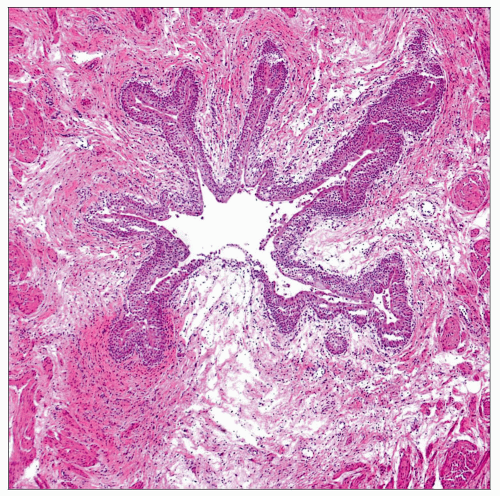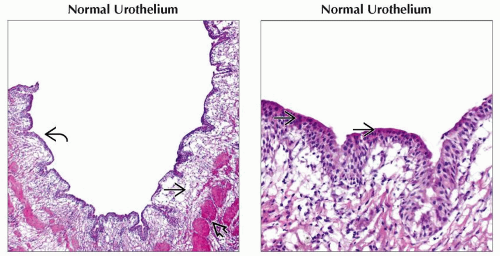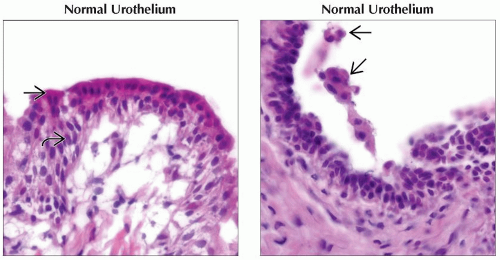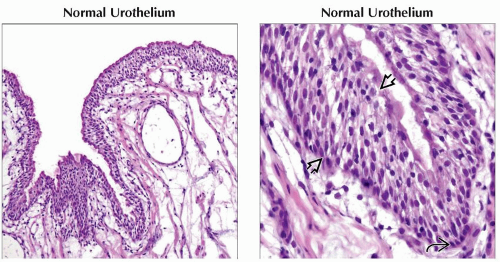Ureter: Margins
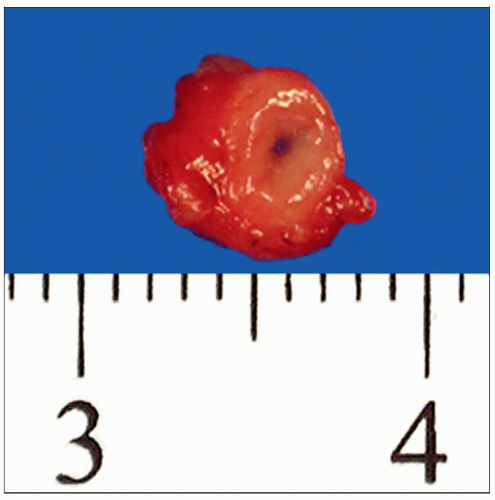 A small length of ureter received for frozen section should be oriented and embedded in such a way that a complete cross section of the lumen is obtained. (Courtesy A. Joiner, MD.) |
SURGICAL/CLINICAL CONSIDERATIONS
Goal of Consultation
Determine if ureteral margins on cystectomy specimen are free of carcinoma and atypia
Change in Patient Management
Additional ureter may be resected to achieve tumor-free margins
Clinical Setting
Cystectomies are usually performed for muscle-invasive urothelial carcinomas (pT2) and therapy-refractory urothelial carcinoma in situ
Patients with positive margins are at higher risk for recurrence within remaining upper urinary tract
SPECIMEN EVALUATION
Gross
Small length of ureter is usually provided
True margin should be identified if specimen is too long to be entirely frozen
Often identified by presence of stitch or clip at 1 end of ureter segment
Ureter may be received inverted with mucosal lining on outer surface
Frozen Section
Cross section of margin is embedded with true margin face up so that 1st frozen section will be true margin
If complete cross section of urothelium is not seen on initial sections, deeper levels should be obtained
MOST COMMON DIAGNOSIS
Urothelial Carcinoma In Situ (CIS)
Urothelium appears crowded, with loss of polarity and nuclear overlapping
Cells are enlarged, hyperchromatic, and pleomorphic
Full-thickness atypia is not required
Due to loss of cell cohesion, prominent denudation may be present
Underlying connective tissue may have associated vascular congestion and inflammation
REPORTING
Frozen Section
Positive for CIS &/or invasive carcinoma
Atypical cells present
PITFALLS
Umbrella Cells
Can be mistaken for tumor cells
Reactive Epithelial Changes
Nuclei are enlarged but appear more uniform than CIS and have vesicular nuclei with single small nucleolus
Occasional mitotic figures may be present but should not be atypical
Acute or chronic inflammation is often present within urothelium
Frozen Section Artifact
Urothelial cells artifactually appear larger and more hyperchromatic on frozen section than on permanent sections
Subepithelial Involvement
In rare instances, soft tissue and muscle layers of ureter may contain invasive urothelial carcinoma whereas urothelial mucosa is uninvolved
RELATED REFERENCES
1. Gakis G et al: Sequential resection of malignant ureteral margins at radical cystectomy: a critical assessment of the value of frozen section analysis. World J Urol. 29(4):451-6, 2011
Image Gallery
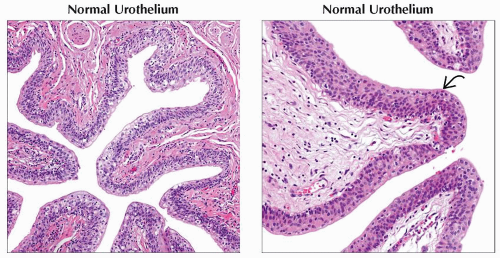 (Left) A permanent section of a ureter margin shows the typical star-shaped appearance of the lumen on cross section. The urothelium has an overall orderly appearance on low power, with no nuclear enlargement or loss of normal polarity. (Right) The cells of normal urothelium have lightly eosinophilic cytoplasm and uniform round to ovoid nuclei. A single umbrella cell layer
 is present at the luminal surface. The subepithelial connective tissue contains scattered lymphocytes. is present at the luminal surface. The subepithelial connective tissue contains scattered lymphocytes.Stay updated, free articles. Join our Telegram channel
Full access? Get Clinical Tree
 Get Clinical Tree app for offline access
Get Clinical Tree app for offline access

|
